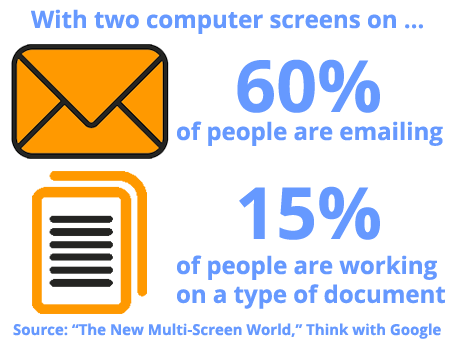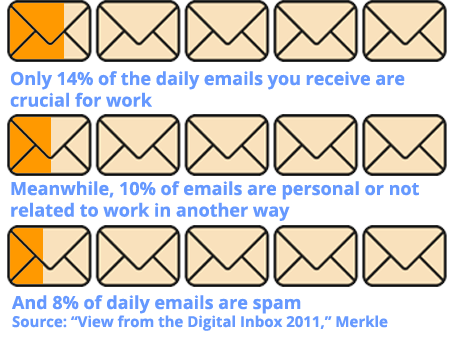Why you should stop using email to collaborate
There’s no denying it. Email is an essential communication tool. It’s the go-to way for most business teams to send messages and documents. A 2012 study by email software company Mimecast says people spend an average of four hours each workday sending and receiving these messages. We’re so used to our email clients that many of us would be lost without them.
But just because email is important for communication doesn’t mean you should use it to collaborate. Yes, that means communication and collaboration are different. Communication can be one-sided. That happens when someone sends a message and expects another person to simply follow it. Collaboration involves people seamlessly exchanging ideas to create a product or a service.
This is how email falls short. It makes it hard for people to work as a group.
Emails restrict group information exchange
Change is inevitable as projects develop. There are a few reasons why this is part of Sandglaz’s philosophy.
Fixed plans rarely, if ever, stick in dynamic industries such as marketing or software development. People share research, feedback and eye-opening data. Of course, they’ll adapt their ideas to this new information and re-imagine projects that are halfway done. Doing so is the best way to create impressive final products. This is why change is inevitable and should be welcomed by keeping an open mind.
Unfortunately, email doesn’t allow for the exchange of information that leads to this improvement. Sending attachments through email is ideal when only one other person needs them. Two people can easily give one another a few rounds of feedback.
But things get confusing when you send a document to a large group. Often, people look over the file individually instead of as a team. Other people only send important information to certain team members. This causes multiple people to make changes to the same version of a file without consulting each other.
Plus, there’s often no way of telling who sent the document to people outside an email thread for edits. Suddenly, the original author has contradicting and overlapping suggestions from people who should be working closely together. This lack of collaboration wastes everyone’s time.
New team members can’t easily collaborate
When new team members join a project, forwarding long email threads for context causes frustration. How many times have you frantically searched through a chain of messages to find a certain comment? In some cases, you’d have a better chance of finding a specific grain of sand on the beach. This time-consuming task is why 60% of us are emailing when we have two computer screens on, according to a Google study. Reading through countless messages to understand the development of a product is stressful, too.
 People who are new to a project also face challenges finding documents. How many times has someone asked you to send them a certain file? This person probably has to ask because scouring through a day’s worth of emails is too tiring.
People who are new to a project also face challenges finding documents. How many times has someone asked you to send them a certain file? This person probably has to ask because scouring through a day’s worth of emails is too tiring.
New team members should be able to join a project and easily access the most up-to-date information. But the private nature of inboxes doesn’t allow for seamless, real-time sharing. Rather, inboxes hide the newest files and information behind password-protected computers and mobile devices. This is another reason why you should stop using email to collaborate.
Your inbox is too distracting
Collaboration involves participation. You have to contribute to discussions and bounce ideas off other people. But doing so is far too challenging through email. This is because your inbox is too distracting.
How distracting? The Mimecast study states wasting time on non-essential emails is the most stressful part of going through inboxes for 62% of people. This takes time away from managing messages that are essential to collaboration.
 It’s clear how this happens. You could receive hundreds of emails each day depending on the size of your team. Irrelevant conversations bury important ones. It’s difficult to stay focused simply because you frantically reply to clear space. Trying to solve this problem, many people sort their inbox through labels and folders. But these messages still count toward that growing number of unread emails. This is why Inbox Zero is a state many people can only dream of achieving.
It’s clear how this happens. You could receive hundreds of emails each day depending on the size of your team. Irrelevant conversations bury important ones. It’s difficult to stay focused simply because you frantically reply to clear space. Trying to solve this problem, many people sort their inbox through labels and folders. But these messages still count toward that growing number of unread emails. This is why Inbox Zero is a state many people can only dream of achieving.
The stress of handling an inbox is why a growing number of people want to send and receive fewer emails. Customer relationship marketing agency Merkle conducted a survey that reveals 43% of people viewed email as “fun” in 2010. That compares with 55% of people in 2008. With such stress and inefficiency, it’s no wonder why French employers and unions signed a legally-binding agreement to ban email after 6 p.m. earlier this year.
Quite simply, many of your teammates don’t want to rely on email. This means that email is not only bad for collaboration, but most people would prefer not using it for such purposes. Make your team happier and more efficient – stop using email to collaborate.
Do you still plan on using email to collaborate? How do you improve collaboration among your team members? Tell us in the comments below!